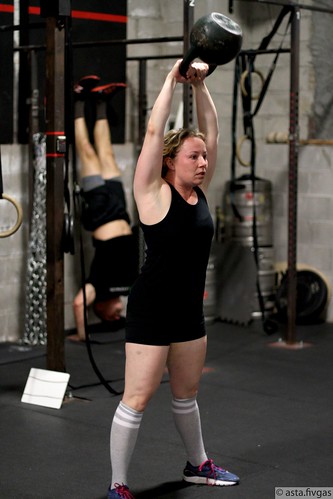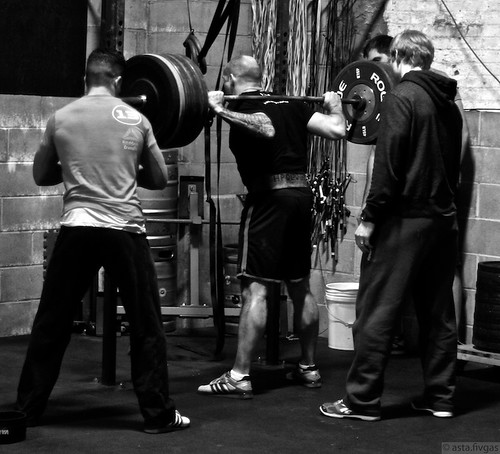The Benefits of Open Gym Sessions at CrossFit Affiliates
 Monday, March 3, 2014 at 12:00AM
Monday, March 3, 2014 at 12:00AM  CFSBK has been offering Open Gym (OG) hours twice per week for a few years now. OG is an opportunity for your members to perform some independent programming, while a coach monitors their training, in an environment that doesn't interfere with normal group classes. This class style is hugely successful and very appreciated, especially by our most senior members. In this article, I’ll discuss more of our rationale behind creating OG hours for our members, and explain how to execute these sessions well.
CFSBK has been offering Open Gym (OG) hours twice per week for a few years now. OG is an opportunity for your members to perform some independent programming, while a coach monitors their training, in an environment that doesn't interfere with normal group classes. This class style is hugely successful and very appreciated, especially by our most senior members. In this article, I’ll discuss more of our rationale behind creating OG hours for our members, and explain how to execute these sessions well.
Why Open Gym?
If it hasn't happened at your affiliate already, you will encounter athletes who want to do their own programming. From an affiliate owner’s and coach’s perspective, allowing anyone to freelance their own programming, especially during normal group class hours, is a recipe for disaster on numerous levels. One, the coach will be unable to monitor what that person is doing, which could lead to safety issues. Two, the space and equipment needs of said people could interfere with what the group class is doing, especially in smaller gyms. Third, this becomes a slippery slope for other members—perhaps even inexperienced members—who will start asking to do their own programming because they see other people doing it. As coaches, its our job to teach movement and facilitate intelligent training at our affiliates, so letting people program for themselves impairs not only our ability to do our jobs well, but also our ability to control the movement quality and overall training culture at the gym.
But on the other side of the spectrum, if athletes have zero control over their own programming, they can start to feel a bit limited, especially if they’re an experienced CrossFitter and have more refined training goals and needs. (Being more experienced doesn’t necessarily mean they’re the most badass athletes in terms of how much they can lift or their times on any given benchmark WOD. To me, being experienced means an athlete has been CrossFitting long enough that they know how to move well and train independently.) We've found our OG sessions to be an excellent compromise, allowing us to offer some training flexibility for our members without it invading our normal group classes, while also allowing us to dedicate a coach’s eyes and expertise to members as they do their own thing. Most of our 600 members never end up attending OG, but there’s a solid enough percentage of them that it’s worth it.
Explaining OG to Our Members
In our Foundations Exit Lecture, we discuss OG and tell new members about it while advising them not to attend until they've completed at least three to six months of consistent training in the group class framework. We describe OG as a more hands-off environment where attendees are expected to have a solid grasp on their training goals and only need basic refinements on the movements they’re working on. The timing stipulation ensures that newer athletes will properly learn our exercises and develop some good training habits by being exposed to the culture of our gym on a consistent basis. In general, we haven't had too many issues over the years of novice athletes going to OG, as they seem to really appreciate all the hands-on attention and thoughtful programming they experience during group classes.
 Logistics
Logistics
Our current OG hours are Fridays from 5:30 to 8 pm and Sundays from 6 to 8 pm. Membership-wise, this class counts as a normal group class or can be purchased as a drop-in on top of monthly memberships. OGers can show up any time during that window and can stay until closing time. The coach on-duty checks in with each person when they arrive to ask what they plan on doing that evening. I usually ask, “What are you working on tonight?” and the athlete’s answer enables me to gather basic details including how they plan to warm-up and how long before they'll be doing a certain lift or WOD. If someone doesn't have a warm-up plan or isn't quite sure what they plan on doing, this is a great opportunity for the coach to advise them based on the group classes they've attended recently and when they plan on coming back. (This is another time when knowing the upcoming programming comes in handy in terms of making smart and informed recommendations for your members).
As people filter into OG, you can also use this information to help economize floor space and equipment usage. For example, if I know Ava is planning on front squatting 120lbs and Beth is going to back squat 135lbs, I'll probably try and organize them together so they end up sharing space. Since OG doesn't require people to show up at a particular time, the coach may have to actively coordinate people's training a bit in the interest of using space well. And usually athletes prefer sharing a bar and don’t mind waiting an extra couple minutes before starting a lift if they need to accommodate the other person.
The coach repeats this process of checking in with athletes and partnering them up or assigning them specific locations in the gym for their particular training. Additionally, the coach actively makes the rounds, checking in on everyone similar to group classes, ensuring everyone gets at least one individual coaching interaction while they're there. In a typical OG, the coach will be spotting people, providing feedback on lifting technique, and offering scaling advice for WODs.
 Keeping People Safe
Keeping People Safe
Remember, just because you're not running a class doesn't make you any less responsible for the safety of the people training under your roof. The types of workouts people will perform at OG depend on the greater training culture at your gym. If people are used to constantly doing 20+ minute chippers, Hero WODs, and max-effort lifting, things can get hairy for the coach real fast and this might not be a great option for your affiliate. Because of our dedicated programming cycles, most people at OG make up lifts they missed that week, perform missed or different WODs, and do accessory work to address weaknesses. So overall, the vibe at our OG sessions is a bit more low-key. But we’re still prepared for when someone comes in and maybe makes imprudent training decisions or starts working beyond their own capacity to stay safe. In those cases, we'll step in to scale them back and modify their training. We’ll probably also advise them on whether they need to remain in group classes longer before coming to OG.
Conclusion
I should also point out that our Open Gym sessions are very chatty, given that people aren’t on such tight schedules and interact with athletes who might usually attend different group classes—which creates an excellent weekly space for easy community building. All told, especially as your affiliate grows, OG can add a very valuable resource on a number of levels for your members. It offers a reasonable solution for athletes who want to responsibly perform some independent programming without interfering with the daily operations of your gym and group classes. It's been a huge win/win for CFSBK. Give it a shot and let us know what you think.

Reader Comments (3)
I thought OG stood for "Original Gangster" :P
Great Post, with lost of valid points. I agree OG isnt for beginners.
wrehaz e3d3fd1842 https://www.miingling.com/pipaterja